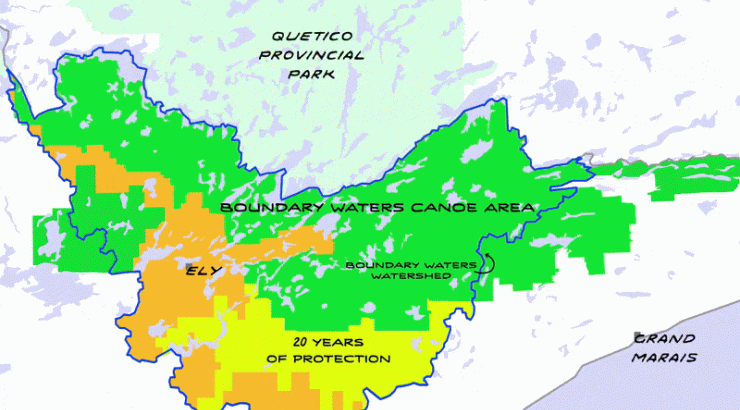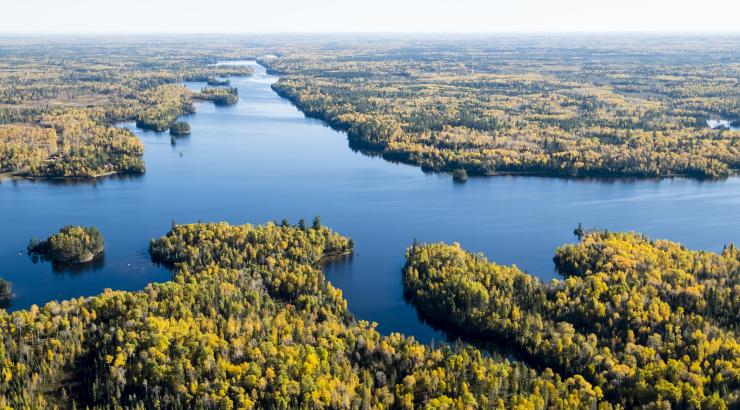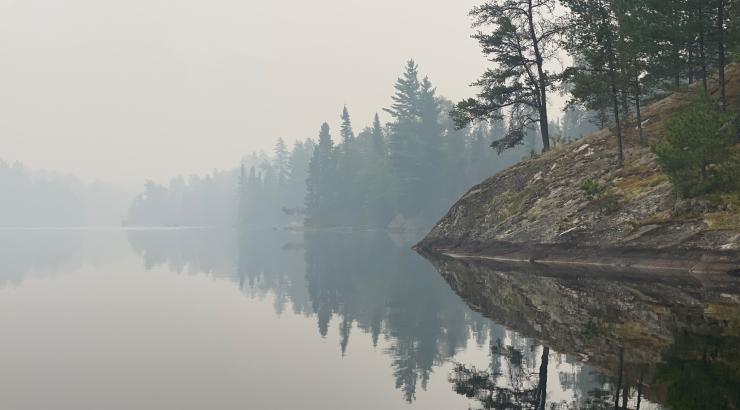The Biden administration has shown they're ready to take bold action to protect our country's most special places, so we're kicking off 100 Days of Action to Save the Boundary Waters to make sure America’s most visited Wilderness is at the top of the list.
"100 days of Action to Save the Boundary Waters" is a multi-week campaign to demonstrate the overwhelming support to protect the Boundary Waters Canoe Area Wilderness from the threat of sulfide-ore copper mining. Each week we will be sharing information around specific themes about the issue of sulfide-ore copper mining on the edge of the Wilderness and asking you to take specific action towards protecting the Wilderness. There will be opportunities to learn more about the issue and to test your existing knowledge.
Nearly 70% of Minnesotans support permanent protection for the Boundary Waters. Are you one of them?

Week 13: Public Health Week
As the mental and physical tolls of the COVID-19 pandemic weigh heavily on our communities, the Boundary Waters has seen a record number of visitors. This is in great part due to the fact that people have been seeking out outdoor sanctuaries like the Boundary Waters Wilderness, where they can heal, rest and rejuvenate themselves in a safe and socially distanced way.
Many veterans will travel to the Wilderness, sometimes shortly after service as a way to refamiliarize themselves with civilian life, and other times to support and nurture their mental health, especially in terms of dealing with PTSD.
Sulfide-ore copper mining poses a health risk to the communities surrounding the Boundary Waters because of the high likelihood of surface and groundwater pollution along with acid mine drainage.
The pollutants associated with this type of mining are linked to a heightened risk of cancer, lung disease, heart disease, and neurodevelopmental disease. As a result, the Minnesota Academy of Family Physicians, Minnesota Medical Association, Minnesota Nurses Association, Minnesota Public Health Association, and over 150 medical providers have raised concerns about sulfide-ore copper mining because of the tremendous public health risks associated with it.

Week 12: Artist Week
There are many artisans that support permanent protection of the Boundary Waters. From chefs to photographers, painters to writers, all creators take inspiration from this incredible place, and want to be a part of making sure it is protected for the next generations. Read the full blog: https://www.

Week 11: Wilderness Communities
The Boundary Waters is the prime natural amenity in the Arrowhead region’s diversified and growing economy, and the wilderness-edge lifestyle this region offers creates the foundation for a stable and sustainable economy.
The 1.1 million acres of canoe routes, hiking trails, and campsites has made Northern Minnesota a world-class destination and provides unlimited year-round opportunities for high-quality backcountry fishing, wildlife watching, and dozens of other accessible recreational activities.
A risky, untested Twin Metals mine at the edge of the Boundary Waters’ watershed would not only destroy an irreplaceable natural treasure, but it would also irrevocably harm the neighboring communities. Sulfide-ore copper mining on the edge of the Boundary Waters would cause major losses in local jobs, visitor spending, property value, and more. Studies show that sulfide-ore copper mining is a job killer, and threats to the amenity-based economy could cost up to 22,000 local jobs and between $402 million and $1.6 billion in total annual income.

Week 10: Climate Change
The Boundary Waters is threatened by sulfide-ore copper mining which would have disatrous implications on wildlife, clean water, and the climate.
- The Boundary Waters region is vital for carbon sequestration
Boreal forests are highly efficient at trapping carbon. Sequestering carbon in these forests and keeping it out of the atmosphere is a vital part of the fight to keep warming below 2 degrees Celsius. - Deforestation and Endangered Species
Mine construction could lead to severe deforestation, making survival difficult for endangered species like the northern long-eared bat, Canada lynx, and gray wolf - which rely on the Wilderness for their habitat. - Biological Diversity
The Boundary Waters area is identified as a crucial landscape to conserve biological diversity in the face of climate change - but only because it is a large, healthy, intact ecosystem; any degration reduces that capacity immensely.
Resources:
Quetico - Benefits of Climate/Forests Protection
MinnPost- Twin Metals Potential Impact

Week 9: Bipartisan Support of the BWCA
The Twin Metals Mine Goes Against Minnesota’s Long History of Bipartisan Support for Protecting the Boundary Waters. It has been a key policy priority for decades of presidential administrations.
-
In 1909, under President Taft, the U.S. and Canada signed the Boundary Waters Treaty, which prohibits the pollution of, “boundary waters, or waters that flow across the boundary, to an extent that would cause injury to health or property in the other country.” (Save the Boundary Waters)
-
In 1964, under President Johnson, the Boundary Waters Canoe Area Wilderness was designated by the Wilderness Act, becoming one of the original wilderness areas in the National Wilderness Preservation System. (Save the Boundary Waters)
-
In 1978, under President Carter, the Boundary Waters Canoe Area Wilderness Act was signed, banning mineral exploration and mining both inside of the Wilderness and in a “Mining Protection Area” located outside of the Boundary Waters. (Save the Boundary Waters) //(Pub.L. 95-495)
-
In 2016, under President Obama, the U.S. Forest Service withheld consent to renewal of federal mineral leases for Twin Metals, a sulfide-ore copper mine proposed on the edge of the Wilderness. The Bureau of Land Management subsequently terminated the leases. (Save the Boundary Waters)
Resources:

Week 8: Legacy of the Boundary Waters
The Boundary Waters is a place fully embedded in the identity of Minnesota, and a vital part of the diverse tapestry of American public lands. It is also threatened by a risky, untested sulfide-ore copper mine, which would contaminate the Wilderness area for centuries to come. Located in the upstream half of the Wilderness watershed, the Twin Metals sulfide-ore copper mine would release toxic metals and other contaminants into the air and water, jeopardizing rivers and lakes where Minnesotans have spent more than a century fishing, swimming, camping, and making cherished memories with their families and friends. Minnesotans and all Americans who love the Boundary Waters will fight to protect this special place for generations to come.
Resources:
Pictographics, thread, paddle planner
Walter Mondale and Theodore Roosevelt IV op-ed
Kids for the Boundary Waters- video about Boundary Waters Youth Advocates

Week 7: Wildlife of the Wilderness
The wildlife of the Boundary Waters is as biologically diverse as it is divine. The Wilderness is home to the largest population of wolves in the U.S. and endangered species like the Canada lynx and gray wolf. Animals like moose, beaver, bears, deer, bobcats, distinctive fish and aquatic animals rely on the wilderness undisturbed ecosystems for survival. When waterways are contaminated, it jeopardizes the entire ecosystem. The twin metals mine would severely impact this unique environment.
-
The pristine waters and unspoiled forests of the Boundary Waters and Superior National Forest provide critical habitat for wildlife, including three federally threatened species (Canada lynx, gray wolf, northern long-eared bat), and is a refuge for moose, a species of special concern to the State of Minnesota. (Save the Boundary Waters)
-
The Boundary Waters and Superior National Forest are a designated Important Bird Area, with more than 316 bird species detected, including 171 breeding species, and the highest diversity on earth of breeding warbler species. (Fitzpatrick, 2017)
Resources:
Impacts to fish/fisheries study
Birds of the Boreal Forest - w/ Jacob Job and Steve Piragis
Endangered Species Threatened by Proposed Sulfide-Ore Copper Mining in Boundary Waters

Week 6: The Clean Water Legacy of the Boundary Waters
Copper Mining Threatens the Clean Water Legacy of the Wilderness. Sulfide-ore copper mining is considered the riskiest type of mining, with byproducts such as acid drainage, sulfates and sulfides, and heavy metals, all of which degrade water quality.
-
The Environmental Protection Agency (EPA) has deemed metal mining as the United States’ most toxic industry. Hard rock mining, most of which is metal-sulfide mining, contributes to more Superfund sites than any other activity. This is due to polluted mine drainage, a side effect of mining rock with significant metal-sulfide content. (Environmental Protection Agency, April 2020)
-
Sulfide-ore copper mining is much more toxic than Minnesota’s taconite mining. Mining of this ore body would produce giant waste piles that, when exposed to air and water, leach sulfuric acid, heavy metals, sulfates, and sulfide. These byproducts pollute not just land, air, and soil, but groundwater, wetlands, rivers, and lakes as well. (Minerals Engineering, May 2000)
-
Pollution from these mines will inevitably flow directly into the heart of the Boundary Waters. Peer-reviewed research shows that pollution from a mine in this watershed, like Twin Metals, even under normal mining operations, would generate contaminants that would flow directly into the Wilderness. This type of mine can generate pollution lasting more than 500 years. (Journal of Hydrology, February 2016) // (Minnesota Department of Natural Resources, 2013)
-
Because of the Boundary Waters’ interconnected groundwater, wetlands, and abundant lakes and streams, the area is especially vulnerable. The many streams, wetlands, lakes, and aquifers downstream of the proposed mine sites are massively interconnected. Consequently, contamination would be widespread, and damage from an accident would be uncontrollable. (Earthworks, 2018)
-
The U.S. Forest Service concluded that a sulfide-ore copper mine, specifically Twin Metals, poses an “unacceptable risk of irreparable harm” to the Boundary Waters. Antofagasta, the company that owns Twin Metals, is proposing to store over a hundred million tons of toxic waste on the shores of Birch Lake, which flows directly into the Wilderness. (United States Forest Service, 2016)
-
There exists no technology today or envisioned tomorrow that can guarantee protection of downstream waters from sulfide-ore copper mining. A review of state-of-the-art technologies available to modern copper mine construction found that none could eliminate risk to downstream waters. (Center for Science in Public Participation, November 2014)
History shows that sulfide-ore copper mining is especially prone to accidents that release pollution into watersheds.
-
93% of copper mines in the U.S. have experienced a spill or accidental release. A study of 15 sulfide-ore copper mines in the United States – representing 99% of current U.S. copper production – found that 14 (93%) experienced accidental releases of pollution that resulted in significant water contamination. (Earthworks, May 2019)
-
In 2014, an accident at the Mount Polley copper and gold mine in British Columbia released 4.5 million cubic meters of toxic slurry into a lake and river system, which was a priceless salmon spawning area and tourism generator. (Earthworks, February 2015)
-
In 2014, a mine in Mexico spilled 40,000 cubic meters of copper sulfate acid solution into two rivers, wiping out the water supply for a vast rural area that depended on the river water for domestic use and agriculture. (AP, August 2014)
Resources:
Hydrological Map
As Goes the Watershed, So Goes the Water
Today Show: Couple spending a year outdoors to protect Boundary Waters from mine pollution
Paddle to D.C. Excerpt
Acid mine drainage risks – A modeling approach to siting mine facilities in Northern Minnesota USA

Week 5: A World Class Wilderness Experience
The Boundary Waters is a world-class Wilderness experience right in our own backyard. An hour and half from Duluth and less than five hours from the Twin Cities, the Boundary Waters is one of the premier Wilderness destinations in the entire world, bringing in over 150,000 visitors per year.
Some of what makes the Boundary Waters unique:
-
The Boundary Waters holds unmatched opportunity for year-round wilderness recreation. It offers 1200 miles of canoe routes, 237 miles of overnight hiking trails, 2,000 campsites, and unlimited opportunities for high-quality backcountry fishing, wildlife watching, and year-round recreational activities. (Save the Boundary Waters)
-
The Boundary Waters Canoe Area Wilderness is the largest National Wilderness Area east of the Rockies and north of the Everglades, covering more than 1.1 million acres within the 3-million-acre Superior National Forest, which contains 20 percent of all the fresh water in the entire National Forest System. (Save the Boundary Waters) // (US Forest Service)
-
The Boundary Waters watershed forms the heart of a trans-national protected area referred to as the Quetico-Superior ecosystem. It includes the Boundary Waters and Voyageurs National Park in the U.S. and Quetico Provincial Park in Canadian. It totals nearly 2.5 million acres, making it the largest canoe-country wilderness in North America.
-
In addition to the U.S. and Canada, other nations include the Grand Portage, Bois Forte, and Fond du Lac Bands of Lake Superior Chippewa, which retain treaty rights to hunt, fish, gather, and conduct cultural practices on the lands of the 1854 Treaty Ceded Territory in the U.S., and the Lac La Croix and Couchiching First Nations, whose traditional lands and waters are downstream from the Boundary Waters
-
The pristine waters and unspoiled forests of the Boundary Waters and Superior National Forest provide critical habitat for wildlife, including three federally threatened species (Canada lynx, gray wolf, northern long-eared bat), and is a refuge for moose, a species of special concern to the State of Minnesota. (Save the Boundary Waters)
-
The Boundary Waters and Superior National Forest are a designated Important Bird Area, with more than 316 bird species detected, including 171 breeding species, and the highest diversity on earth of breeding warbler species. (Fitzpatrick, 2017)
Resources:
Conservation Alliance: Priority Campaign Spotlight: The Boundary Waters Canoe Area Wilderness
International Dark-Sky Association: Boundary Waters Canoe Area Wilderness Named the Largest Dark Sky Sanctuary
National Geographic: A pristine American backcountry faces down an environmental crisis
KEEN Story Camp Boundary Waters

Week 4: Kids and Camps of the Boundary Waters
Youth and adult camps surround the Boundary Waters and are directly in the Twin Metals path of pollution. Proposed sulfide-ore copper mining will ruin these longstanding educational centers. Generations of Minnesota families have sent their kids and grandkids to life-defining experiences in and near the Boundary Waters. The Twin Cities YMCA operates three youth camps and two family camps in the Wilderness area including Camp Kooch-i-ching, operating on Rainy Lake since the 1920’s, is also on the path of pollution.
Resources:
Kids for the Boundary Waters
Kids for the Boundary Waters - Elsa Soderstrom
Wilderness Inquiry
Together in the Wilderness - Mpls/St. Paul Magazine
Youth and Family Camps that use the BWCA

Week 3: The Economic Value of the Wilderness
The Boundary Waters sustains the livelihoods of thousands of Minnesotans and studies show that protecting the Wilderness is the better economic choice for the sustainability of the region.
-
The Boundary Waters is a major driver of a tourism economy that generates over $900 million in revenue annually and sustains 17,000 jobs, which support local families and businesses. (Explore MN)
-
Destructive sulfide-ore copper mining in the region would undermine asset value, and cost an estimated $509 million in lost property value. Local property tax revenues, which support local government services in the region, would suffer as a result. (Boundary Waters Business Coalition)
-
Introducing sulfide-ore copper mining on the edge of the Boundary Waters will have an overall negative effect on the regional economy over a 20-year time period. Though such mining might lead to temporary growth in employment and income, over time, the economic benefits of mining would be outweighed by the negative impact of mining on the recreational industry and in-migration, leading to a boom-and-bust cycle. (Harvard University Department of Economics)
Resources:
Boundary Waters Business Coalition
The Timberjay Editorial (2017)
Harvard University Department of Economics (2018)
Summary: Key-Log Economic Report (2018)

Week 2: Environmental Threat
Sulfide-ore copper mining will cause irreversible environmental damage to the Boundary Waters. Dozens of scientific analyses have shown that hardrock mining on the Boundary Waters’ doorstep will cause irreparable harm to this irreplaceable Wilderness. A few of the most important scientific findings include:
-
The Environmental Protection Agency (EPA) has deemed metal mining as the United States’ most toxic industry.
-
Pollution from these mines will inevitably flow directly into the heart of the Boundary Waters.
-
Because of the Boundary Waters’ interconnected groundwater, wetlands, and abundant lakes and streams, the area is especially vulnerable.
-
Acid mine drainage could wipe out local fish species. Heavy metals and associated pollutants from sulfide-ore copper mines harm microorganisms, aquatic plants, and fish.

Week 1: Path to Permanent Protection
The Boundary Waters Canoe Area Wilderness is threatened by proposed sulfide-ore copper mining. Chilean mining conglomerate Antofagasta's Twin Metals project was terminated in 2016 by the US Forest Service because it posed a threat of irreparable harm to an irreplaceable Wilderness. It was resurrected by the Trump administration and was being fast-tracked through inadequate reviews and negative changes to bedrock environmental laws.
2021 is our best chance to permanently protect the Boundary Waters. We continue to work on several fronts focused on permanently prohibiting sulfide-ore mining in the Boundary Waters watershed. Our path to permanent protection includes re-initiating a federal mineral withdrawal, passing a permanent protection bill in Congress and the MN legislature, ongoing litigation to terminate the unlawful leases, using science to push back against the proposed mine plan and revising the state's rules regulating mining.
Resources:



